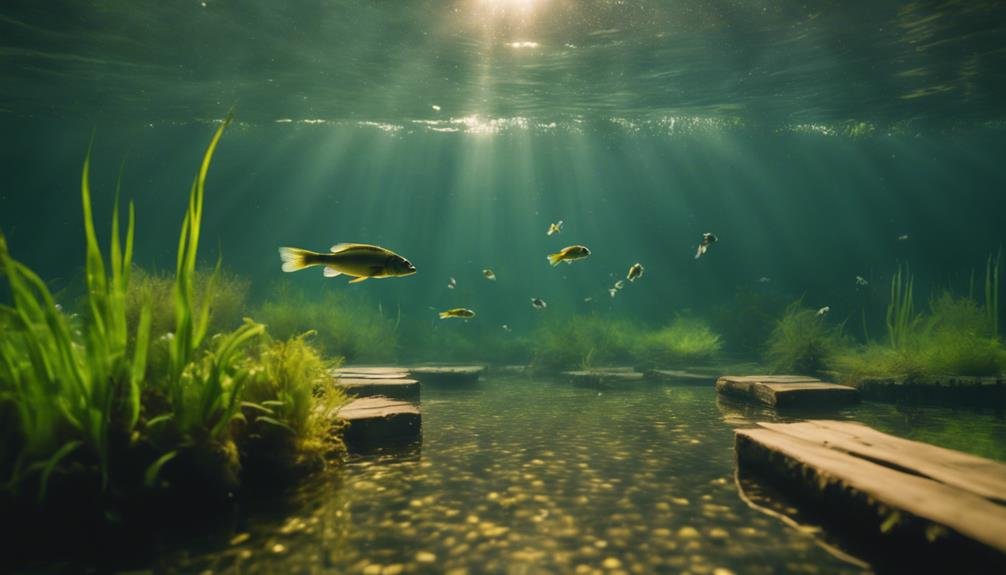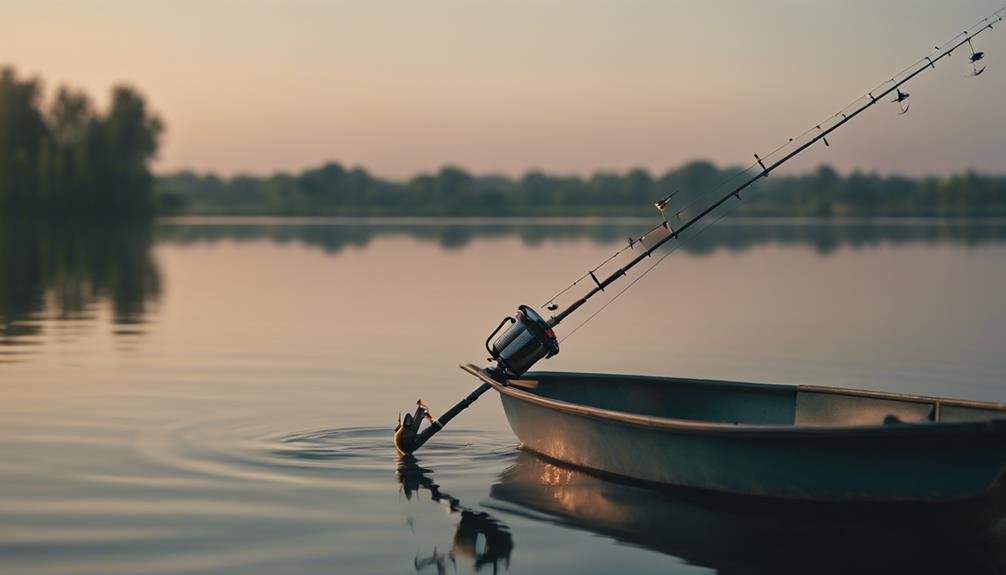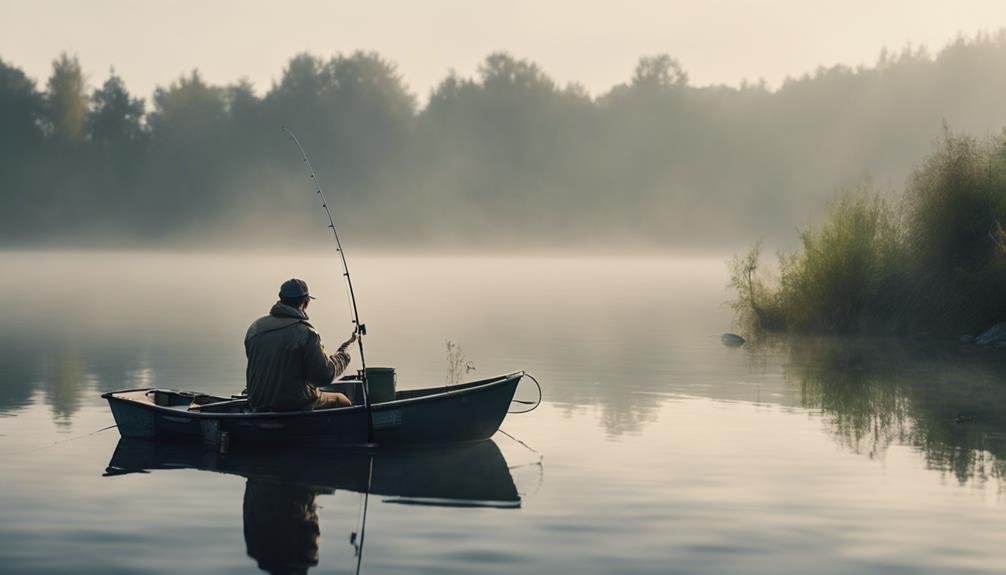It would be best to start by understanding their behavior and habitat when aiming to catch Perch. erch are often found in shallower waters near structures, weed beds, and drop-offs. Sing ultralight to light spinning rods with sensitive lines can improve your fishing experience, and live bait like worms or minnows tends to attract them effectively. But don’t overlook artificial lures; small spinners and jigs can be incredibly effective, too. if you’re wondering about the best techniques or specific times to fish for PPerch, there’s more you should know before heading to your favorite fishing spot.
Key Takeaways
- Use ultralight spinning rods with a 4-6 pound line for better sensitivity and control.
- Fish during dawn and dusk whePerchch are the most active and feeding.
- Employ live bait like worms or minnows to attract research effectively.
- Experiment with small artificial lures like spinners and jigs to mimic prey.
- Target drop-offs, underwater structures, and weed beds to locate perch schools.
Understanding Perch Behavior

To effectively catch Perchch, you need to understand its behaviour and habitat preferences. They are freshwater fish that thrive in lakes, ponds, and slow-flowing rivers with plenty of vegetation. They typically move in groups, which means that when you catch one, there are likely more fish around.
Perch are daytime feeders, and their activity peaks at dawn and dusk. During these times, you’ll find them feeding in shallower waters, especially in the spring when they migrate from deeper waters. They look for small fish, insects, larvae, and crustaceans to eat, so your bait should mimic these food sources for the best results.
As the seasons change, so does perch behavior. In the spring, perch move to shallow water to feed and spawn. In the summer, they head back to deeper water to stay cool and find food. Understanding these patterns helps you know where to cast your line and what bait to use.
When targeting Perchch, focus on areas with abundant vegetation in shallow and deeper waters. Se bait that resembles their natural diet to increase your chances of a successful catch.
Choosing the Right Equipment
Selecting the right equipment is essential for increasing your chances of catching. Tart with an ultralight to light spinning rod paired with a 4-6 pound line. His setup provides the sensitivity to detect subtle perch bites and the strength to reel them in without breaking your line.
When it comes to lures, consider using inline spinners and small crankbaits. These can effectively mimic the small prey perch feed on, increasing your chances of a successful catch. Additionally, live bait such as worms, minnows, or leeches can be highly effective, especially when paired with the right bait rigging techniques.
For float fishing, utilize slip bobbers. Hey, it allows you to adjust the depth of your bait easily, making them perfect for targeting. Perchch in shallow waters. lip bobbers also visually indicate bites, helping you react quickly.
Experimenting with different hooks is also essential. Maller hooks are generally more effective for Perchch, ensuring a better set without spooking the fish. ombine these hooks with various lures and live bait to find what works best in your fishing spot.
Using Live Bait

Selecting the right kind of live bait is essential when using it to catch. Orms, minnows, or insect larvae can be tried to see what works best.
To keep your bait lively and attractive, make sure you hook it properly, whether through the lips or back.
Choosing Right Bait
Hooking the right live bait can significantly boost your chances of catching. Nightcrawlers and red worms are particularly effective. Heir natural movement and scent in the water attracPerchch, making them irresistible targets.
When hooked through the lips or back, Minnows mimic the natural prey of oPerchch, adding another layer of attraction. Heir darting movements trigger the predatory instincts of oPerchch, increasing your chances of a successful catch.
Insect larvae such as maggots, waxworms, and mealworms are also excellent choices, especially during ice fishing. These larvae provide a unique scent and movement that perch find hard to resist. Maggots, for instance, are small but potent, and their wriggling can be seen from a distance, drawing in. Axworms and mealworms offer similar benefits in terms of their writhing movements and appealing scent.
Experimenting with different live bait options can help determine what works best in your fishing location. Each can be finicky, so having a variety of live bait on hand ensures you’ll have the right option to lure them in.
Hooking Techniques Explained
Mastering proper hooking of live bait will maximize its effectiveness in attracting perch. Perch often respond best to live bait that mimics their natural prey. When using worms, hook them through the end to allow for natural movement that can entice perch. Minnows are another excellent option; hook them through the lips or back to keep them alive and swimming naturally, making them irresistible to perch.
Experiment with different rigging techniques to see what works best in your fishing environment. for instance, try hooking nightcrawlers or red worms in various ways to find the most effective method.
Here’s a quick guide on hooking techniques for different bait options:
| Bait Option | Hooking Technique | Natural Movement |
|---|---|---|
| Worms | Hook through the end | Mimics natural wriggling |
| Minnows | Hook through the lips or back | Imitates swimming |
| Insect Larvae | Hook through the body | Mimics crawling |
These hooking techniques will help your bait stay lively and natural, making it more likely to attract Perch. December Perch Perch requires some experimentation to find the right combination of bait and technique. Don’t hesitate to try different methods until you find what best to entice Perch Perchtively.
Effective Artificial Lures
Choosing the right artificial lure can greatly enhance your chances of catching Perch. Ch spinners are fantastic artificial lures because they mimic small fish or insects, especially in clear water. ir reflective blades create enticing flashes that attract Perch, Making them a go-to choice for a successful catch.
Jigs are also excellent, imitating the movement of worms and larvae. bouncing them off the bottom, you can effectively target Perch Perchare lurking in deeper waters.
Crankbaits work wonders, too. y resemble the movement of small bait fish and are particularly effective during the mornings and evenings when Perch Perchost is active. ir erratic swimming patterns can be incredibly enticing to perch.
Another great option is inline spinners, which simulate the movement of small prey. Their spinning action can make them irresistible to perch, increasing your chances of landing one.
Experimenting with these artificial lures—small spinners, jigs, crankbaits, and inline spinners—can help determine what works best for enticing Perch Perchte. Varying your approach and adapting to the conditions can transform your fishing experience into a more productive and enjoyable adventure.
Best Fishing Techniques

When targeting Perch, Perching and trolling are two effective techniques worth exploring.
Choose the right bait, such as small minnows or worms, to increase your chances.
Experiment with these methods to see which works best in your fishing spot.
Jigging and Trolling
Explore two of the most effective techniques for catching Perch: Perching and trolling. Ging uses a lead-head lure to bounce off the bottom, mimicking the natural prey movement to attract Perch. The perch method is especially effective in deeper waters where Perch Perche is suspended. varying the depths and speeds of your jigging, you can locate the Perch’Perch’srred feeding zone. The key is to keep the lure moving in a way that resembles the erratic motion of prey, enticing Perch Perchrike.
Conversely, trolling covers more water to locate active schools of Perch. The perch technique entails slowly moving your boat with bait or lures trailing behind. s particularly useful when you’re in search of feeding perch. Experimenting with different trolling speeds and depths can help determine the most productive approach. usting your setup based on perch activity can enhance your chances of a successful catch.
These techniques can greatly boost your perch fishing success, whether jigging near the bottom or trolling across broader areas. Ck with them, and you’ll be reeling in Perch Perch time.
Bait Selection Tips
Selecting the right bait is essential for maximizing your perch fishing success. Adding bait selection, you have options between live bait and artificial lures. Baits like worms, minnows, and insect larvae are incredibly effective. I’ve been natural and appealing to Perch, especially when experimenting with different bait rigging techniques.
| Bait Type | Examples |
|---|---|
| Live Baits | Worms, Minnows, Insect Larvae |
| Artificial Lures | Small Spinners, Jigs, Crankbaits |
Artificial lures like small spinners, jigs, and crankbaits mimic natural prey and can be just as effective. The tip is to match the size of your bait to the size of the Perch you’re purchasing. ller perch prefer percher baits, while larger perch prefer bigger offerings.
| Technique | Benefit |
|---|---|
| Match the Size | Targets perch more effectively |
| Keep Bait Moving | Triggers feeding response |
Another key tactic is to keep your bait or lures moving. This action attracts Perch and teachers to their feeding response. Whether you’re using live bait or artificial lures, the right bait and technique will significantly increase your chances of a successful perch fishing trip.
Finding Ideal Spots
Finding ideal spots to catch Perch involves understanding their seasonal movement patterns and preferred habitats. Perch are known to change their location based on water temperatures and available cover. In the spring, you’ll find Perch in shallow waters of 3-8 feet when water temperatures are between 45-50 degrees.
As the water warms in summer, look for Perch in dePerchwaters, around 10-25 feet, near drop-offs and underwater structures. These areas provide them with safety and ample feeding opportunities.
In the fall, target perch in depths of 8-12 feet near weed beds with soft bottoms. These environments offer the food and shelter perch needs during this season. Ter perch fishing is best in shallow waters 3-5 feet deep with heavy weed growth.
Always pay attention to changes in topography and rock piles, as these can also be ideal perch spots.
Here are some tips to help you find the best spots:
- Look for drop-offs and underwater structures.
- Pay attention to changes in topography.
- Fish near weed beds, especially in fall and winter.
- Check for soft bottoms in shallow waters.
- Observe other anglers and their successful spots.
Tips for Success

Mastering the art of perch fishing involves using light gear and sensitive rods to detect subtle bites. Initial tackle is important because Perch has tiny nibbles that heavier gear might miss—close attention to your rod tip for small movements that might indicate a bite.
Lures work well for perch fishing, especially small jigs and spinners, which mimic the baitfish perch love.
ExPerchent uses different bait sizes, types, and techniques to catch perch. You might need to try various lures and live bait to see what attracts them on a given day. tools of Perch often change depths, so fishing at different depths can help you find where they bite.
The best perch fishing usually happens during dawn and dusk when Perch are active. Ust your techniques based on the time of day and water conditions, such as clarity and temperature. k for underwater structures, changes in topography, and currents, as these are prime perch hotspots.
Stay patient, observant, and adaptable. Because behavior can change quickly; being ready to adjust your approach will increase your chances of success.
Conclusion
You’ve now got the essentials to catch Perch succePerchly! Ultralight gear, choose the right bait, and experiment with lures.
Focus on techniques like jigging and trolling, and always fish during dawn or dusk for the best results.
Find shallow waters near structures and weed beds to locate active schools.
With these tips, you’re all set for a rewarding perch fishing experience. Py fishing!
FAQs
What is the best bait for catching perch?
The best bait for catching perch includes live bait such as worms, minnows, and insect larvae. Ch are opportunistic feeders and are attracted to movement, so live bait works well to entice them. facial lures like small spinners, jigs, and soft plastics can also be effective, especially when mimicking the appearance and movement of small prey.
Top Bait Choices:
- Live Bait: Worms, minnows, insect larvae.
- Artificial Lures: Small spinners, jigs, soft plastics.
What are the best techniques for catching perch?
Effective techniques for catching perch include jigging, drifting, and still fishing. ging involves using a small jig or lure that is moved up and down in the water to attract perch. fting allows the bait to move naturally with the current, making it an attractive option for perch. Ll fishing with live bait, where the bait is suspended in the water column, can also be productive, especially in areas where perch are known to school.
Fishing Techniques:
- Jigging: Use small jigs or lures to mimic prey.
- Drifting: Let the bait move naturally with the current.
- Still Fishing: Suspend live bait in the water column.
Where is the best place to catch perch?
Perch are often found in freshwater lakes, rivers, and ponds, especially in areas with structures like weed beds, submerged logs, or drop-offs. In warmer months, they tend to stay in shallow waters, while in cooler months, they move to deeper waters. Morning and late afternoon are the best times to catch perch, as they are more active and feed during these periods.
Best Fishing Spots:
- Weed Beds and Structures: Look for areas with vegetation or submerged logs.
- Shallow Waters: Best during warmer months.
- Deeper Waters: Perch moves deeper in cooler months.

